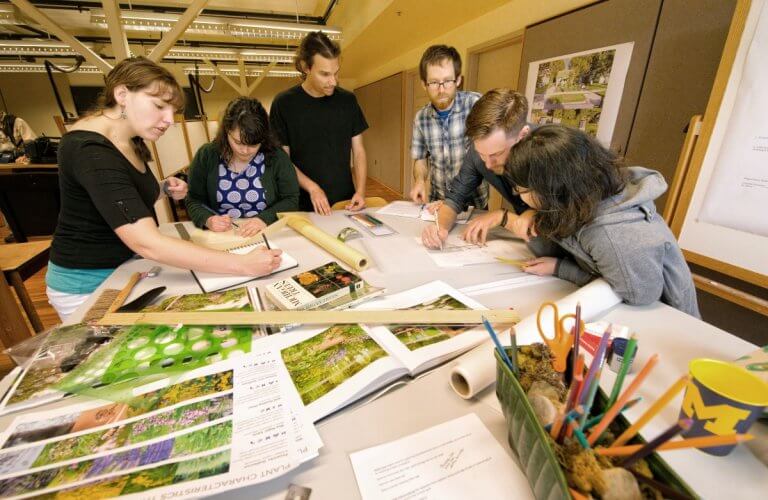
“More more more – Michigan is the Midwest state that cranks it up. It sports more beaches than the Atlantic seaboard. More than half the state is covered by forests…colored sandstone cliffs and trekkable sand dunes also woo visitors.” – Lonely Planet
Home to the street capital of Detroit and four of five Great Lakes in the US, Michigan beholds the best of urban life and nature. It’s a state that encompasses 36 million acres of land – including 11,000 inland lakes, 36,000 miles of river, and an abundant 20 million acres of forest.
Also home to seven national parks, heritage areas and trails; two large national wildlife refuges; and the 60,000-acre Sleeping Bear Dunes Wildness State Park, it’s easy to see why Michigan is considered a haven for global citizens with a love for the natural world and who are passionate about sustainable living.
Enter the University of Michigan (UM): a top-ranked public research university named third-best in the US in terms of value for money. Located in Ann Arbor – a buzzing university town, culinary delight and notable tech hub – this institution offers a vibrant learning experience and empowers graduate success.
Founded in 1903, UM’s School for Environment and Sustainability (SEAS) has long been leader of the field. Committed to the protection of Earth’s finite resources, staff and students of this school advocate for a healthy, sustainable society. Through research, teaching and outreach, every member of the SEAS network is devoted to the management and conservation of the planet’s natural assets.
Here, the wonder of the great outdoors can be seen at every turn. This stunning backdrop proves invaluable to any aspiring professional hoping to make waves in the environmental sector. Here, wildlife thrives, offering the chance to examine fascinating creatures within their natural habitat. All the while, diverse research and learning opportunities help students settle on their specialisation, ensuring talents and passions are best placed so they can forge a long and impactful career.

Source: University of Michigan
Beyond classroom walls, students at SEAS are submerged in unrivalled, real-world field settings, covering everything from urban gardens to secluded forests, nature reserves that span 1,761 acres, 854-acres of botanical landscapes and a 500-acre arboretum. Combine this with the school’s elite instructors and faculty-student ratio of 1:7, and you can see why SEAS is an engine for growth among environmental scientists and scholars.
SEAS embodies a cross-campus learning journey, allowing students to complement coursework with electives from any of UM’s 18 other schools and colleges.
Hosting the largest alumni network of any environmental program in the US, more than 8,000 qualified UM graduates influence sustainable policies and practices on all corners of the globe. The most popular program is the Master of Science, a degree that offers study pathways in Conservation Ecology, Environmental Informatics, Sustainable Systems, Environmental Policy and Planning, to name just a few.
A distinguishing element of the SEAS Master’s program lies in its interdisciplinary intentions – an aim extended to dual degree format. Every study field provides the perfect foundation for a dual degree, with students choosing specialisations from the following regions: Engineering, Business, Urban and Regional Planning, and Law.
On top of this, the joint degree delivered alongside the UM Ross School of Business through the Erb Institute is known as the very first program of its kind. Then there’s the Master of Landscape Architecture – one of the world’s only programs to employ ecological principles in environmentally-responsible design.
“You’ll be blown away by the conversations that you have, the people that you meet, the faculty that are interested in getting to know you and also helping to achieve your dreams and your goals,” says Andrew Sell, a graduate of UM’s Landscape Architecture program.

Source: University of Michigan
The Master of Science in Environmental Justice is a distinctly unique offering, exploring sustainable development topics from completely new perspectives.
Merging public health, urban planning, public policy, law, sociology and political science, this is the country’s first course of its kind, delving into a new yet sought-after area of sustainable development.
Informed by the latest industry developments, this degree dissects the deep challenges and complexities that underlie sustainability, unravelling the issues different countries and regions face in reaching their ultimate goal.
A degree in environmental studies is a key to the door of nearly every industry. From local heritage sites to nature reserves, government agencies to international organizations, research institutes to broadcast companies, environmental graduates are as relevant as they are in-demand.
The seamless critical/analytical skillset refined through higher learning in such a a hands-on subject are greatly desired in a complex modern world. And there’s no better place to start this journey than at the SEAS, UM.
“More than any other university, we have the potential to be so much more than the sum of our many excellent parts,” the institution eloquently concludes.
“It’s this potential to have a positive impact on the society we serve that represents our greatest value as a university.”
Follow the School for Environment and Sustainability at the University of Michigan on Facebook, Twitter, YouTube and Instagram
Liked this? Then you’ll love…
Be part of the sustainable future with a degree in environmental science
Learn the nuances of environmental development at the University of Michigan







